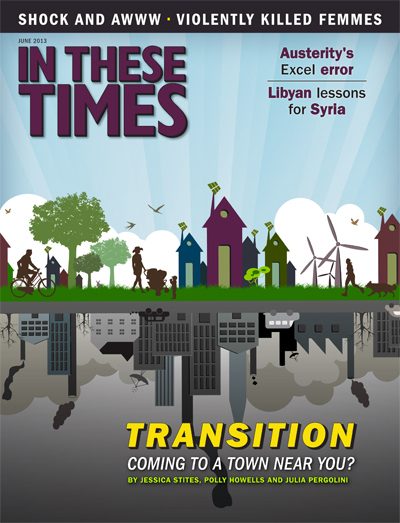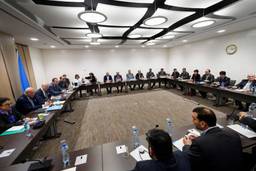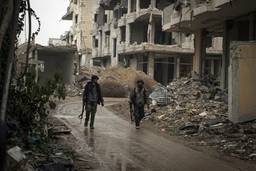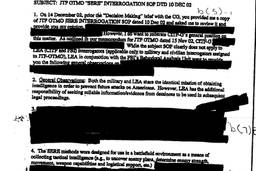In Syria, Unlearned Lessons from Libya
Why does the U.S. believe that only violent overthrow will work?
Stephen R. Weissman
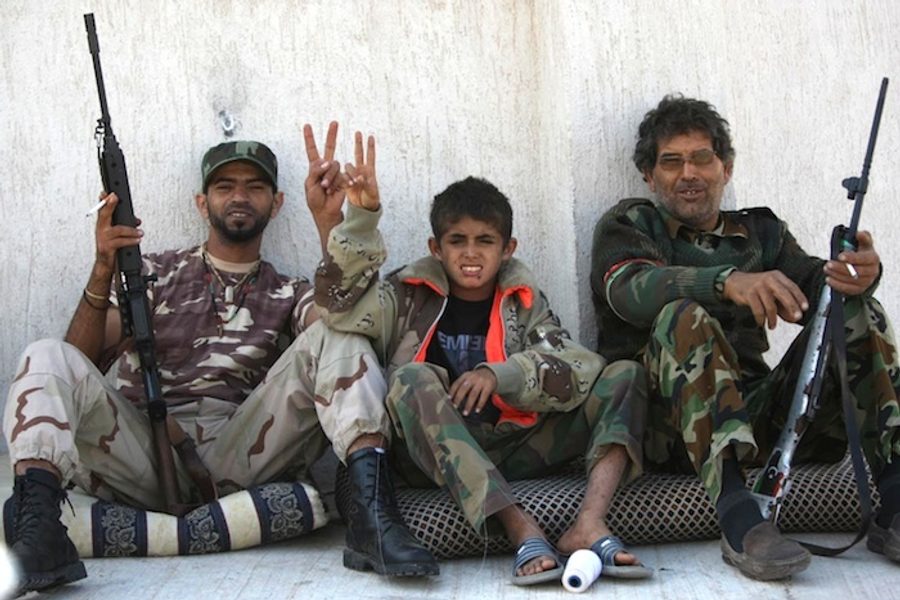
While media attention has turned to fresher news, the conflict in Syria rages on and the West becomes ever more deeply embroiled. The United States is training Syrian insurgents in neighboring Jordan, increasing deliveries of “non-lethal” military equipment, and helping coordinate the military aid flowing to the Free Syrian Army from Turkey, Saudi Arabia and Qatar. Meanwhile, the British and French are poised to send in arms.
The U.S. appears to be following the same philosophy in Syria that it did in Libya in 2011 — one laid bare by Secretary of State Hillary Clinton’s comment after receiving the news that Libyan dictator Muammar Gaddafi had been killed: “We came, we saw, he died.” In other words, the U.S. believed that the best way of protecting Libyan civilians and promoting a democratic transition was to help armed insurgents overthrow the regime. Now, that approach seems to be solidifying into a Libya paradigm among Western policymakers. Already at work in Syria, it might someday be applied to internal conflicts in Iran, the Russian Caucusus or elsewhere.
But that paradigm warrants questioning. While military intervention succeeded in helping remove a brutal dictator and giving Libyans an opportunity to build a more accountable political system, it had other unfavorable consequences for Libya, the region and the world:
- In the absence of an international peace-keeping force, lawless and revenge-seeking militias (similar to those that murdered U.S. Ambassador Christopher Stevens) are significantly constraining political progress in post-war Libya.
- The undisciplined exit of arms, ethnic fighters and Islamist extremists from Libya precipitated the takeover of half the nation of Mali and strengthened Islamist extremist groups in North and West Africa, including those who recently took foreign hostages at a natural gas installation in Algeria
- Russia’s alienation over NATO’s interpretation of the U.N. Security Council Resolution authorizing U.S. and NATO military intervention has made it less willing to cooperate with the three Western Permanent members of the Council on managing the conflict in Syria and other matters
- Iran and North Korea have drawn the lesson that abandoning their nuclear efforts — as Libya did — could risk Western-sponsored overthrow of their governments.
Is it true that the U.S. and NATO had no better course than purely violent regime change in Libya? Other international actors — the African Union, Russia and a United Nations Special Envoy – pursued a different path. Accepting the need for foreign military intervention to protect civilians endangered by civil war, they undertook serious efforts to mediate a peaceful political transition to democracy. An examination of the international public record and interviews with officials of relevant countries and international organizations reveals considerable, if not conclusive, evidence that using NATO’s military leverage to support a negotiated, internationally supervised political transition could have achieved Western objectives at far less cost.
The West’s humanitarian smokescreen
To consider whether there was a viable alternative policy towards the Libyan crisis, it’s first necessary to understand the path that Western leaders actually pursued. Despite the public emphasis on humanitarian protection, plenty of evidence betrays that their primary goal was violent regime change.
In Libya’s chapter of the Arab Spring, the government’s brutal repression of widespread peaceful demonstrations in February 2011 quickly morphed into a raging civil war. The U.S., Great Britain and France, who for decades had cozied up with dictatorships in the Arab world, were caught by surprise by the wave of popular unrest. Seeking to reposition themselves as supporters of political change, they decided to wholeheartedly embrace the Libyan revolution. Although Gaddafi, who had held power for 42 years, had disbanded his nuclear weapons program and normalized relations with the West, his past support of terrorism and flamboyant style made him easy to demonize.
NATO’s official position was that the bombing would end when the Libyan government unilaterally implemented a ceasefire and withdrew its forces from at least three contested cities. Yet American, British and French officials who were involved in Libyan policy at the working level attest that U.S and NATO operations were designed from early on not only “to protect civilians … threatened with attack” (the sole object of force according to the U.N. Security Council’s March 17th Resolution), but also to help rebels overthrow the Gaddafi regime. But their testimonials are not the only convincing evidence. According to an official African Union report, in meetings with an AU delegation on April 20-21, 2011, American officials stressed that any ceasefire “should also include Col. Gaddafi’s departure from power.” In contrast with previous NATO bombing to protect civilians in Bosnia and Kosovo, there was no NATO offer to Gaddafi to discuss the conditions for implementation of a ceasefire and no NATO initiative for a diplomatic settlement. None were necessary, of course, if the purpose of intervention was military victory.
It is therefore impossible to avoid the conclusion that President Obama lied on March 28 when he told the American people, ten days into the NATO bombing campaign, “Broadening our military mission to include regime change would be a mistake.” Less than three days later, while Deputy Secretary of State James Steinberg was repeating this assurance to the Senate Foreign Relations Committee, Secretary of Defense Robert Gates was telling the Senate Armed Services Committee, “There’s clearly a lot of people across Libya that are ready to rise up against this guy. And if we can sufficiently degrade his military capacity, it seems to me this gives them the opportunity to do that.”
It was only in October 2012, during his foreign policy debate with Republican presidential candidate Mitt Romney, that Obama explicitly acknowledged the real purposes of his policy:
But you know… when we went into Libya and we were able to immediately stop the massacre there because of the unique circumstances and the coalition that we had helped to organize, we also had to make sure that Muammar Gadhafi didn’t stay there… Muammar Gadhafi had more American blood on his hands than any individual other than Osama bin Laden. And so we were going to make sure that we finished the job.
So U.S. and NATO policy went well beyond the U.N. resolution’s mandate to protect civilians. And in fact, full reading of the resolution demonstrates its focus on alternatives to violent regime change. Paragraph 1 demands “the immediate establishment of a ceasefire and a complete end to violence.” Normally, these are achieved by negotiations between the government and other parties to the conflict. Paragraph 2, originally drafted by South Africa, stressed the need to “find a solution to the crisis which responds to the legitimate demands of the Libyan people,” noting upcoming missions to Libya by a U.N. Special Envoy and the African Union’s ad hoc High Level Committee, “with the aim of facilitating dialogue to lead to the political reforms necessary to find a peaceful and sustainable solution.”
The African Union’s prescription
The continent’s regional organization had been developing an alternative approach to the crisis even before the U.N. passed its resolution. Concerned about the threat to peace in Libya and the region, the African Union’s Peace and Security Council produced a few-sentence “roadmap” on March 10 emphasizing an immediate ceasefire and an “inclusive” transition to democracy.
On April 10, 2011, less than two months after the uprisings that sparked Libya’s civil war, the African Union sent its new High Level ad Hoc Committee on Libya to Tripoli for discussions with Colonel Gaddafi. The delegation included the presidents of Mauritania, Mali, South Africa and Congo and the foreign minister of Uganda (representing the president). By then, the United States and other NATO countries had been bombing Libyan government air defenses and forces for three weeks.
Like the U.S. and NATO, the AU had set its sights on the exodus of Gaddafi — but through different means. According to scholar Alex de Waal, a former Senior AU Adviser on Sudan who interviewed top AU staff members, the Committee “envisaged” that under the roadmap Gaddafi would step down within months, allowing an inclusive transitional government (including both former rebels and acceptable regime figures) to shepherd democratic elections. A diplomatic source close to President Jacob Zuma of South Africa confirmed to me, “The mission was to get him out of power [after] a few months of negotiations.”
Gaddafi understood the African leaders’ intent when he met with them, says de Waal. The Libyan leader responded by condemning the rebels as drug addicts, criminals and Al Qaeda-linked terrorists and strongly opposing the committee’s planned visit to rebel-held Benghazi. The Africans were not intimidated. They replied, according to de Waal, “that Libya lacked the means to stand up to the international coalition, … that the Libyan government had no choice but to negotiate with the [rebel] Transitional National Council and that any solution had to be based on the aspirations of the Libyan people to democracy and respect for human rights.”
In the end, Gaddafi gave the Committee what it considered a positive response: He confirmed his support for a ceasefire accompanied by an effective and credible monitoring system, and accepted the vague language of the roadmap intended to transition him from power.
The next day the Committee set out for Benghazi to meet with the rebels’ Interim Transitional National Council (TNC). In the discussion, the rebels laid out two preconditions for entering negotiations: the removal of Gaddafi and his family from power, and the unilateral withdrawal of government forces from contested cities. Neither of these, the AU knew, were things to which Gaddafi would readily consent.
As the civil war intensified, the AU committee worked to narrow the differences between the parties and coax them into negotiations toward democracy. In a six-hour meeting with President Zuma on May 31, Col. Gaddafi repeated his endorsement of the roadmap but emphasized that he was not prepared to leave his country. Days later, Mauritanian President Mohamed Ould Abdel Aziz, the chair of the committee, responded, telling the press, “Gaddafi can no longer lead Libya. His departure has become necessary.”
A moment of leverage
As spring became summer, the rebels’ position strengthened, putting the Libyan government in a difficult military situation. By the end of May, the TNC held almost all of Eastern Libya, along with the major city of Misurata and the Western Nafusa mountains. The government had lost control of perhaps half the country and nearly all of the oil resources. NATO claimed to have destroyed 50 percent of the Governnment’s military capacity. American, British, French and other intelligence services were improving the rebels’ organization and coordination with NATO, and Qatari weapons and trainers were arriving to assist the Western mountain insurgents.
Meanwhile, regional organizations and countries that Gaddafi had hoped would be more understanding—like the African Union, which he had supported financially, or Russia, which had sold him arms—had made it clear that his regime’s time was up. Under pressure from France, the U.S. and the U.K., Russia signed on to a May 28 G8 statement that Gaddafi “had lost all legitimacy” and “must go.” Concerned since the Iraq War about the consequences of Western military-backed regime change, Russia considered the AU undertaking to be “the optimal option” for a diplomatic settlement. Russia and the AU offered only to make Gaddafi’s withdrawal less humiliating and to allow his inner circle and followers to play a role in the transition to democracy.
In late May and June, Gaddafi responded to these circumstances by making significant concessions to the AU mediators. At the same time, top regime insiders journeyed secretly to the United States and France with proposals for an inclusive transitional government and Gaddafi’s gradual withdrawal. In mid-June, Washington Post columnist David Ignatius reported that Gaddafi’s long-time intelligence chief and brother-in-law, Abdullah al Senussi, had sent emissaries to Washington to meet with State Department and other officials. They proposed a gradual transfer of power to a new government that would bring together the TNC and technocratic “reconcilables” from the regime. Gaddafi would leave power and quit Tripoli as an outcome rather than a precondition of negotiations, to preserve his “dignity.” The emissaries said that although their initiative was not explicitly authorized by Gaddafi, they thought they could convince him if they could work out a deal. It appears that the U.S. did not thoroughly explore this proposal, rejecting it as “not meaningful” or “credibly authorized,” according to a high State Department official.
Diplomatic and press sources reported a similar approach to France by the director of Gaddafi’s Political Bureau, Bachir Salah and by former French Prime Minister Dominique de Villepin. On July 12, Foreign Minister Alain Juppe revealed that “Emissaries are telling us Gaddafi’s ready to go, let’s talk about it.” French Prime Minister François Fillon told the National Assembly a “political solution is taking shape.” The French proposed several formulas (the contents largely unknown), including options for Gaddafi to stay somewhere in Libya or go into exile. When it heard from its interlocutors that the terms were not acceptable to Gaddafi, France did not attempt to continue discussions or work with the AU.
Despite Gaddafi’s reluctance to discuss his exit, it became clear between late May and late June that his position was evolving in the direction the African Union desired. Gaddafi and his government accepted “an inclusive dialogue process” with the TNC in which Gaddafi himself would not be involved. Gaddafi also confirmed that the Libyan government was open to withdrawing its forces from contested cities if the rebels would also stand down.
Armed with these concessions, on July 1 the African Union proposed a “Framework Agreement” that stipulated immediate negotiations between the Libyan parties under AU and UN supervision. To allow for talks, it called for an informal suspension of hostilities and a “humanitarian pause” in NATO operations — which had become a Libyan government precondition for talks.
At the heart of the Framework Agreement was a comprehensive ceasefire with a sizeable UN Peacekeeping Force linked to the establishment of an “inclusive, consensual interim government.” These would pave the way for the adoption of a democratic constitution and holding of elections. To advance national reconciliation, there would be an amnesty law covering certain crimes committed during the conflict, and a possible Truth and Reconciliation Commission.
A window closes
Both Libyan parties issued generally positive statements concerning the African Union plan. President Zuma urged NATO Secretary-General Rasmussen to persuade the TNC to negotiate. He agreed only to convey the request. The TNC’s response came back quickly: Gaddafi and his family must go in advance of any negotiations.
At this point, the AU process began to fall apart. The Western-led Libya Contact Group decided on July 15 that the only intermediary the international coalition would recognize was the U.N. Special Envoy Abdel Elah Al-Khatib. However, his efforts had not advanced as far as the AU’s and were less strategic. For example, he never met Gaddafi and he never presented a full and final peace proposal to the parties, preferring to dwell on individual details.
The AU was still waiting for the TNC’s formal response to the Framework Agreement when the rebels entered Tripoli in late August, rendering the Framework moot. A few weeks later, President Zuma complained that NATO policies had “deliberately undermined” the African initiative.
Was negotiated regime change possible?
What would have happened if the U.S. and NATO had used their military leverage to support AU and U.N. mediators seeking to bring in an inclusive transitional government and ease Gaddafi out?
As discussed, there was a window in the summer of 2011 when the only significant obstacle to the government’s entering negotiations seemed to be its insistence on the ending of NATO bombing. NATO could have removed this roadblock by agreeing to the “humanitarian pause” requested by the AU.
The TNC, too, was balking at negotiating, at least until Gaddafi relinquished power. But it’s hard to believe that the TNC would have maintained that position if its Western allies had wielded the threat of reduced assistance. The rebels’ line on the coastal road going west was hardly budging; the success of a future Western front depended heavily on NATO bombing and other military aid from countries in the NATO-led coalition. A Western diplomat who was deeply involved with Libya policy observed to me, “The TNC could have been pushed to change its position … if there were a stalemate for an extended period of time.” One indication of the TNC’s potential flexibility was its June offer to al-Khatib to allow Gaddafi to remain in Libya under U.N. guard if he abandoned power. The offer was withdrawn towards the end of July when the TNC’s military and diplomatic position improved.
Assuming that negotiations had begun under the AU Framework, the main danger was that Gaddafi would have tried to hang on to power now that the military pressure was off. Behind the scenes, he might have attempted to consolidate his remaining forces and either stall the establishment of a transitional government or influence some of its members to delay genuine free elections.
Yet the Framework’s tight provision for the early buildup of a “sizeable” U.N. peacekeeping force to monitor a ceasefire and protect civilians would have deflated Gaddafi’s most important political asset: his battered army. His political supporters would have gotten the message. (Indeed, regime insiders were already seeking a way out). So would the considerable civilian opposition in Tripoli, which would have grasped any opportunity to express itself publicly. Furthermore, a united international community could have wielded the sticks of toughening economic sanctions and enforcing the warrant for Gaddafi’s arrest for trial at the International Criminal Court, as well as the carrot of offering him protection when he left power, either in Libya or abroad. In addition, any eruption of violence—whichever side provoked it – could have sparked renewed intervention by NATO forces. The transition might have been messy and taken longer than expected, but there was a reasonable chance of success.
Had negotiated regime change succeeded, the U.N. force could have worked with the interim government to establish unified security forces that integrated TNC militias and government troops. The main threat to Libyan political progress today – lawless, revenge-seeking militias—would have been alleviated. There would have been more international control over military stocks, so they wouldn’t have leaked out of the country to fuel regional conflicts and terrorism. The Russian government would not have been so alienated by U.S. and NATO policy. And the insecurity of the two main nuclear problem countries, North Korea and Iran—their fear that denuclearization would encourage foreign military intervention as in Libya—would have been eased.
In the worst case, Gaddafi would have somehow managed to thwart the negotiations and hang on to a rump U.N.-occupied, NATO-patrolled portion of Libya. But he would have then had to confront broader and more intensified international sanctions and opprobrium.
Under those circumstances, the U.S. might have reverted to the policy that it had told Congress it was pursuing in Libya. In his spring 2011 testimony before the House and Senate Foreign Affairs Committees, Deputy Secretary of State Steinberg referenced the two-stage approach that had succeeded in Kosovo. First NATO had completed its humanitarian military operation; then the West had applied “political and economic pressure” that helped the Serbian people dislodge President Milosevic in elections one year later. A like course in Libya would not only have promoted democratic change, but also given the Libyan opposition time to develop broader and more coherent political and security structures, easing the post-conflict transition.
Less violent regime change was surely worth a serious try. Although there is no way to prove definitively that there could have been a negotiated transition to democracy (or, failing that, sanctions-led political change), there was good reason to be cautiously hopeful.
Lessons for Syria
As the crisis in Syria deepens, U.S. and NATO policymakers and, more importantly, their publics, should be wary of carelessly generalizing from their Libyan “success” and pursuing a purely military solution. Instead, analysis of the missed opportunities and baneful consequences of the Libyan experience suggests that policymakers should take advantage of the current military stalemate in Syria and work with the international community to foster negotiations between the Opposition and less-tarnished elements of the Syrian regime. The goals would be similar to those of the African Union in Libya: to establish a U.N-policed ceasefire, install a consensual transitional government, ease out dictator Bashar al-Assad and move towards a democratic constitution and elections. These have in fact been the public recommendations of the two distinguished U.N. mediators in Syria, Kofi Annan and Lakhdar Brahimi.
Given the critical position of Syria in the Middle East, the stakes are much higher than they were in Libya. The U.S. and NATO simply cannot afford to err again.
